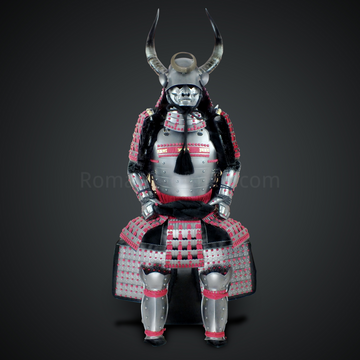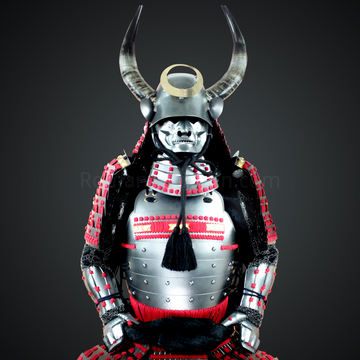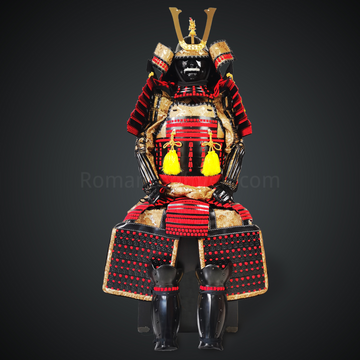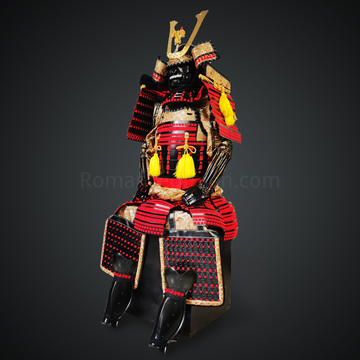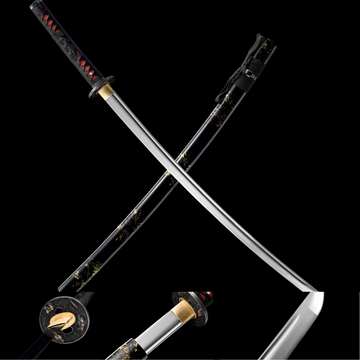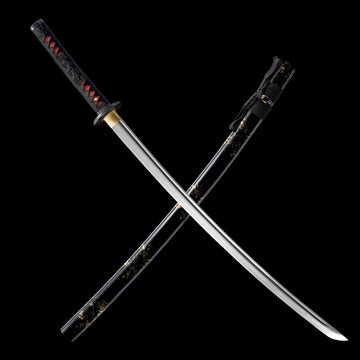Katana Habaki A little component that will make or break your sword experience
Understanding Katana Habaki
Many experts often refer to the habaki as the heart of a Japanese katana sword. It is a small component that is placed in the middle of a katana and has both decorative and practical functions.
Apart from this, it serves other purposes as well. Let's examine the habaki in more detail, along with its materials and its fascinating history.

What is Habaki (鎺)
Habaki (鎺) is the metal collar wrapped at the base of the katana blade, or the front of the nakago (tang), where the blade meets the Tsuba. In Japanese Habaki is "鎺", some might also called it "Saya-bashiri-dome" 鞘走留 or "Koshigin-kin" 腰巾金.
Habaki types include Tachi Habaki, Single Habaki etc, common material include iron, copper, gold and silver. Designs on habaki often features flowers, animals etc. The habaki may not have the visual appeal of the tsuba, menuki or fuchi, it is often an overlooked component of katana fittings (Koshirae). However, its functional importance cannot be underestimated.
Purpose Of The Habaki
In essence, the Habaki acts as a blade collar. Its purpose is to fit the blade in the Saya tightly and prevents the saya from ever coming in direct contact with the blade.
If the Katana's edge touches the inside of its saya, it could get scratched or even start to rust if it stays like that for too long. The inside of the saya is made of wood, it wasn't dirty in the first place. But with use and exposure in battle, it can accumulate blood or other contaminants, potentially leading to rust on the blade. The Habaki keeps the blade suspended inside the saya without touching it so this doesn't happen.
Habaki makes sure the sword doesn't slip out of the saya easily. A secure fit is very important since you don't want the sword to slip out of the sheath unintentionally. Inexperienced swordsmen might tend to grab the blade if it falls out of the sheath and hurt their hands.
It's a balancing act. The habaki should be secure enough not to let the katana slip but should allow the swordsman to draw the katana with a little intentional pressure. Given the importance of habaki, it usually should not be removed unless the katana is completely disassembled.
Common Habaki Materials
Habaki need to be a perfect fit because each Japanese sword is unique, requiring precise craftsmanship to make a Habaki that fits each sword perfectly. The craftsmen who makes habaki are Shirogane-shi (白銀師). The choices of material usually are copper, gold, silver or the same iron as the blade:
Copper (銅): Preferred for practical use, durable and hardens well when hammered. Most common during the Edo period.
Gold (金) and Silver (銀): Often used on prestigious swords that belong to Daimyo. The highest quality of gold are: Solid gold (金無垢, kinmuku) or solid silver (銀無垢, ginmuku). Next in value ones are: Gold-plated (鍍金, tokin) and silver-plated (鍍銀, togin).
But Gold and silver are soft and easy to deform, making them unsuitable for actual combat. So copper with Gold or Silver plating became popular for combining practicality with aesthetics, preferred by stylish samurai.
Iron (鉄): Some will use iron to make habaki and it's called Tomohabaki (共鎺), valued for being made from the same iron as the blade but eventually phased out due to the risk of damaging the blade.
We offer wide range of Habaki options for you to customize your own katana.
Parts on a Habaki
Shimogai (下貝): The part that directly touches the katana blade.
Kaisaki (貝先): The end of the habaki closest to the sword's tip (kissaki) or sharp end.
Nomikomi (呑込み): A notch for the "Machi" (区), a protrusion on the back/spine side of the blade.
Munekata (棟方): The back or spine side of the shimogai.
Daijiri (台尻): The part that touches the "Seppa" (切羽), which keeps the guard from sliding.
Uwagai (上貝): A part that covers the outside of the shimogai, open at the back/spine and edge sides so you can see the shimogai.
Hakata (刃方): The edge side of the shimogai.
Habaki Types

Types of Habaki include:
Tachi Habaki (太刀鎺): Used mostly for tachi swords, these often don't have a notch for the machi (呑込み). They are generally thin with vertical file marks on the surface, suited for practical use in combat due to their lightness and mobility.
Single Habaki (一枚鎺, Ichimai Habaki): A single-layer structure, suitable for any type of sword including uchigatana (打刀), wakizashi (脇差), tantō (短刀), and naginata (薙刀). These habaki can be plain or decorated, often found on Shinto新刀.
Double Habaki (二重鎺 or 袴鎺, Nimai Habaki or Hakama Habaki): Features an outer layer (uwagai) that bulges out over a base layer (shimogai) touching the blade. Primarily, the outer layer is decorated. Though slightly less practical than single habaki, their elegance made them popular for the swords of daimyo in the early Edo period.
Dai-tsuki Habaki (台付鎺): Characterized by a base that interacts with the seppa (切羽) to prevent the guard from sliding. Made from solid gold, these high-quality habaki were often used on famous Koto (古刀) and aikuchi tantō (合口拵, short swords without a guard).
Regional Habaki (お国鎺, Okuni Habaki): With the establishment of the Edo period and the feudal system, silversmiths designed habaki with unique styles for different clans. Famous types include Owari (尾張鎺), Osaka (大坂鎺), Mito (水戸鎺), Kaga (加州鎺), Shōnai (庄内鎺), Higo (肥後鎺), and Satsuma (薩摩鎺) habaki.
Variation Habaki (変わり鎺, Kawari Habaki): In peaceful times, more decorative and delicately made habaki appeared, featuring intricate designs that were not necessarily practical. These include shapes inspired by Mount Fuji, chrysanthemums, and waves.
Covered Habaki (着鎺, Kise Habaki): These are made by covering a metal base with a thin metal sheet, often using brazing. Typically made from copper (素銅, Suaka) due to its hardness and resistance to deformation, these habaki are brightened with gold or silver coverings to enhance the sword's appearance.
Gold-covered (金着鎺, Kinkise Habaki) and silver-covered (銀着鎺, Ginkise Habaki) are the two main types, with gold-covered ones being particularly prestigious during the Edo period, restricted to high-ranking samurai and daimyo.
Habaki Designs
The common types of Habaki designs include intricate and symbolic patterns that enhance the aesthetic and cultural value of the katana. Here we will introduce the most common themes and designs:
Aoi Crest (葵紋): This design features the Aoi (triple hollyhock) crest, which is associated with the Tokugawa family. It symbolizes the connection to the Mito Tokugawa lineage, appearing on habaki from historically significant swords.
Irikobishi (入子菱): A pattern of nested diamonds, symbolizing prosperity and abundance. This design is often used for its auspicious connotations, representing fertility and the hope for a prosperous lineage.
Animal Motifs (e.g., Horses): Dynamic animal figures such as horses are incorporated into habaki designs, symbolizing vitality, strength, and good fortune. Horses, in particular, are considered messengers of the gods in Japanese culture, bringing happiness and prosperity.
Wave and Sunrise Combination (波濤と日の出): A sophisticated carving that combines waves and the rising sun, representing eternal life, renewal, and longevity. The waves signify the endless cycle of life and resilience, while the sunrise is a powerful symbol of rebirth and auspicious beginnings, particularly valued in Japanese tradition.
How to make Habaki

Image source: Facebook 4K Katana project
The process of making a habaki involves a series of complex and critical steps. Here's a simplified summary of the typical stages involved in crafting a habaki:
Material Selection: The process begins with cutting out the base material, typically copper, gold, or silver, which is tailored to the unique dimensions and shape of each individual katana blade.
Forging: The selected material is heated until malleable using a high-temperature burner. It is then hammered out on a metal anvil to extend and shape it appropriately.
Bending and Shaping: After reaching the desired length, the material is bent and heated again to mold it around the sword's tang, ensuring a snug fit without damaging the blade.
Securing the Fit: A thin rod called "machigane 区金" is inserted inside the bent material to help maintain its shape. The ends of the material are not yet joined at this stage.
Soldering: The ends of the material are fixed together using a wire. A mineral called borax is applied to the blade side, and a silver and brass alloy known as "silver wax" is used for soldering. The borax melts into a glass-like flux, and the silver wax flows to complete the joint.
Adjustment: Once the base of the habaki fits the sections of the blade, it is further adjusted by hammering the sides to tighten or loosen the fit as necessary.
Final Shaping and Filing: The habaki is removed from the blade, and various files are used to refine the shape and smooth any rough edges. This step is crucial to prevent any mismatch that could affect subsequent fittings like the sheath or handle.
Decorating and Finishing: Finally, the habaki may be covered with a thin gold plate to enhance its appearance. Decorative elements are added using files and chisels, increasing both the functional and aesthetic value of the habaki.
History Of The Katana Habaki
Despite its long use, experts are still unable to determine where the habaki originated. So, there are a lot of opinions on where it originates from. Interestingly, many say that it first came from China.
It can be traced back to the 8th century in Japan. So, it has a long and rich history in Japanese swords. Even the earliest straight blades featured a habaki.
Habaki FAQs
Q: Can you make the habaki from precious metals?
Ans. Yes, it’s possible to make habaki from precious metals like gold. Even silver works too. However, premium metal can increase the price. The main thing to keep in mind is that it serves its purpose.
Q: Do artisans use adhesives to attach the habaki?
Ans. The habaki doesn't use any adhesive. Craftsmen weld it to form a proper seal. As a result, it provides stability to the sword and also locks the saya.
Conclusion
Without the habaki, the sword will easily slip out of its sheath. And that can be dangerous. Therefore, it's important to ensure that the habaki is well-made and fits perfectly. If you want to learn more about other katana parts, please check this guide.
